

Health Canada
Final Report
December 2023
Prepared for:
Health Canada
Supplier name: Quorus Consulting Group Inc.
Contract award date: October 24, 2023
Delivery date: December 22, 2023
Contract amount (incl. HST): $133,984.10
Contract #: CW2335211
POR number: 068-23
For more information, please contact:
cpab_por-rop_dgcap@hc-sc.gc.ca
Ce rapport est aussi disponible en français.
Mental Health, Substance Use and 9-8-8: Suicide Crisis Helpline - Advertising Concept Testing
Final Report
Prepared for Health Canada
Supplier name: Quorus Consulting Group Inc.
December 2023
This public opinion research report is based on 24 online focus groups that Quorus completed between November 27 and December 5, 2023. Focus groups spanned the country and consisted of a variety of target audiences. The sessions lasted approximately 90 minutes. All participants were informed the research was for the Government of Canada. A total of 169 individuals participated in this study.
Cette publication est aussi disponible en français sous le titre : Santé mentale, consommation de substance et 9-8-8 : ligne d'aide en cas de crise de suicide - Test de concepts publicitaires
This publication may be reproduced for non-commercial purposes only. Prior written permission must be obtained from Health Canada. For more information on this report, please contact Health Canada at: cpab_por-rop_dgcap@hc-sc.gc.ca
Department of Health
200 Eglantine Driveway
A.L. 1915C
Ottawa, Ontario
K1A 0K9
Catalogue Number:
H14-589/2024E-PDF
International Standard Book Number (ISBN):
978-0-660-70842-3
Related publications (registration number: POR 068-23):
Catalogue Number H14-589/2024F-PDF (Final Report, French)
ISBN 978-0-660-70843-0
©His Majesty the King in Right of Canada, as represented by the Minister of Health, 2023


I hereby certify as Senior Officer of Quorus Consulting Group Inc. that the deliverables fully comply with the Government of Canada political neutrality requirements outlined in the Policy on Communications and Federal Identity and the Directive on the Management of Communications- Appendix C.
Specifically, the deliverables do not include information on electoral voting intentions, political party preferences, standings with the electorate or ratings of the performance of a political party or its leaders.
Signed:
-----------------------
December 22, 2023
Rick Nadeau, President
Quorus Consulting Group Inc.
Adverse mental health outcomes, substance use related harms, and death by suicide are significant public health issues affecting peoples of all ages and backgrounds across Canada:
A national ad campaign is planned to address this growing public health issue. It will aim to generate awareness and interest among people in Canada in various stages of seeking mental health, substance use, and suicide prevention support to interact with free resources, services, and supports compiled on Canada.ca/mental-health, including the new 9-8-8 Suicide Crisis Helpline.
The objective of the research was to test the creative concepts for the advertising campaign to determine, based on the following specific goals, which concept resonated most with the target audiences.
Specifically, the goal was to:
The research methodology consisted of 24 online focus groups with individuals in Canada ("participants"). The focus groups were held between November 27 and December 5, 2023, and included individuals from across the country. Focus groups were segmented by six target audiences: parents and caregivers of children between the ages of 10 and 18, youth and young adults aged 15 to 34, Indigenous peoples, members of the 2SLGBTQI+ community, members of racialized communities, and men aged 35+. Each focus group session lasted approximately 90 minutes. Participants were informed upfront that the research was being conducted on behalf of Health Canada and they each received an honorarium of $125 for their participation. In total, 169 individuals participated in the research.
Three advertising concepts were tested with participants:
The concepts are available in the detailed results section of the full report.
The order in which the concepts were shown was randomized. Details on the order of concepts shown per session are available in the appendix in the Moderator's Guide.
Before seeing the concepts, participants were provided the following information:
It should also be noted that, unless otherwise indicated, most feedback and reactions were very consistent across the various target audiences involved in this research.
For this concept, a variation unique to each target audience was tested.Across the groups, Concept A received moderate to positive scores when asked to provide an initial rating.
Those who liked the concept appreciated and understood that the image that one might present to others, often through social media, hides or misrepresents reality.
Participants also appreciated the visual aesthetics of the concept, especially when compared to the much more text-focused approach used in the other two concepts. The combination of an impactful image and a strong headline helped catch participants' attention and effectively deliver the message.
The focus on social media was said to be relatable to younger participants, however it was less relatable to certain participants (especially older ones) who do not use social media much if at all.
Those who did not like Concept A as much mostly struggled with the effort needed to understand how the image "in frame" related to the rest of the concept outside the frame.
As noted above, many also felt that the imagery in general was not sufficiently impactful or representative of someone who is struggling. Without a more obvious visual link to mental health, some felt they would not pay attention to the ad.
As much as participants liked the headline, those who liked the overall concept a bit less felt that the character in their concept was not always in the background and that this weakened the effectiveness of the overall concept.
For this concept, a variation unique to each target audience was tested except for parents/caregiver and for racialized individuals who shared the same concept. Overall, Concept B received moderate scores.
Those who liked the concept enjoyed the simple approach. The small print "inner dialogue" was liked by many and was seen as accurate and relevant as well as intriguing. The "voiceover" approach and first-person perspective were appreciated. Participants felt that the concept reflected how things can look different beyond the surface and that how people portray themselves or how they initially and often automatically tell others about how they are feeling may not actually reflect how they are truly feeling.
Those who did not like Concept B as much felt that while the idea was good, it lacked visual appeal. Specifically, the font and backgrounds used lacked creativity and were a bit bland. Some participants did not enjoy the text-only approach and would prefer to see some visuals. Others felt that the small text was not relatable to them as it appeared too focused on specific experiences or scenarios.
For this concept, all audiences were shown the same concept, followed by an alternative-coloured version. Across the groups, Concept C received moderate scores.
Those who liked the concept felt the message was clear and straightforward. The message that mental health issues can worsen or grow if not treated was deemed to be true and to many, relatable. In the English groups, many liked the directness of the words "get help now" which implied a sense of urgency in the message and gently reminded the reader not to suppress mental health issues.
From a visual perspective, many felt that the font worked well with the message and was eye-catching and creative. Several participants could imagine how the concept could be creatively portrayed as an animation with popping balloons/letters.
Those who did not like Concept C as much felt that the creative aspect seemed a bit childish (specifically the balloon-style font) considering the serious and important topic. As well, many felt the words "left untreated" got lost among the other text. More visuals rather than text-only would be appreciated for this concept.
When participants were asked to consider the alternative version which contained a blue background, reactions were mixed. Some felt that the blue background was more eye-catching and provided more contrast whereas the black and white was more boring. On the other hand, some preferred the black and white concept, suggesting that the blue seemed a bit more childish and lacking seriousness.
Overall, the concept most often chosen as the winning concept was Concept A (Out of Frame), with the other two concepts tied in second place at quite some distance.
Concept A was particularly appealing to youth and young adults, Indigenous Peoples, members of the 2SLGBTQI+ community, parents and caregivers, and men aged 35 and older. Additionally, many suggested that they would switch their votes from Concept B or C when asked to consider the alternate version of Concept A.
Concept B (Honest Answer) and Concept C (Bigger) were also chosen by a fair number of participants as their top choice. Concept B was particularly appealing to Indigenous Peoples where it often was in a virtual tie with Concept A.
Concept C (Bigger) tended to be selected more as the preferred concept by members of racialized communities, by parents and caregivers, and by members of the 2SLGBTQI+ community.
Many participants agreed that they would remember the 9-8-8 phone number.
The website would have much less recall as it did not have a memorable URL. However, participants suggested that they would probably use Google and search "mental health Canada" in order to find the website if they needed to.
Many participants understood that the new 9-8-8 helpline would be intended for more immediate, urgent help and for suicide prevention, while the website would be useful for long-term planning or non-urgent mental health and substance use matters.
A few participants felt that the approach of sharing both resources was a bit confusing once they noticed that the 9-8-8 helpline was intended for situations of crisis whereas they figured the website and phone number would serve the same objective.
Participants felt that the advertisements should make it clear that the helpline is secure and confidential, particularly as there are those who instinctively feel that anything associated with the Government of Canada may not be.
Qualitative research seeks to develop insight and direction rather than quantitatively projectable measures. The purpose is not to generate "statistics" but to hear the full range of opinions on a topic, understand the language participants use, gauge degrees of passion and engagement and to leverage the power of the group to inspire ideas. Participants are encouraged to voice their opinions, irrespective of whether or not that view is shared by others.
Due to the sample size, the special recruitment methods used, and the study objectives themselves, it is clearly understood that the work under discussion is exploratory in nature. The findings are not, nor were they intended to be, projectable to a larger population.
Specifically, it is inappropriate to suggest or to infer that few (or many) real world users would behave in one way simply because few (or many) participants behaved in this way during the sessions. This kind of projection is strictly the prerogative of quantitative research.
Supplier name: Quorus Consulting Group Inc.
Contract number: CW2335211
Contract award date: October 24, 2023
Contract amount (including HST): $133,984.10
For more information, please contact Health Canadaat:
hc.cpab.por-rop.dgcap.sc@canada.ca
Adverse mental health outcomes, substance use related harms, and death by suicide are significant public health issues affecting peoples of all ages and backgrounds across Canada:
A national ad campaign is planned to address this growing public health issue. It will aim to generate awareness and interest among people in Canada in various stages of seeking mental health, substance use, and suicide prevention support to interact with free resources, services, and supports compiled on Canada.ca/mental-health, including the new 9-8-8 Suicide Crisis Helpline.
The objective of the research was to test the creative concepts for the advertising campaign to determine, based on the following specific goals, which concept resonates most with the target audiences.
Specifically, the goal was to:
Before seeing the concepts, participants were provided the following information:
A total of three concepts were tested. For Concept A (Out of Frame) and Concept B (Honest Answer), variations of the concept were shown to each target audience whereas one variation of Concept C (Bigger) was tested with all target audiences. The order in which the concepts were shown was randomized from group to group. Details on the order of concepts shown per session are available in Appendix B, in the Moderator's Guide.
It should also be noted that, unless otherwise indicated, most feedback and reactions were very consistent across the various target audiences involved in this research.
For this concept, a variation unique to each target audience was tested. For youth and young adults, a first variation was tested in the first session, after which a second variation was designed and tested in the remaining three sessions. For all sessions on and after November 29, the second variation designed for youth and young adults was also shown as an alternate "scenario" to all other target audiences. In those sessions, the initially-designed variation was always presented and discussed first, after which the alternate scenario was shown as a visual contrast to obtain quick feedback and to stimulate ideas for additional visual content.
Youth/Young adults 16 to 34 (variation 1)
* tested in group #3
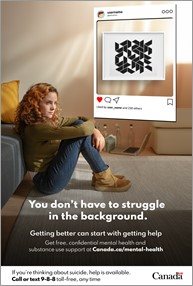
Youth/Young adults 16 to 34 (variation 2)
* tested in groups #5, 19 and 23 and as alternative variation in all other groups with all audiences starting Nov 29
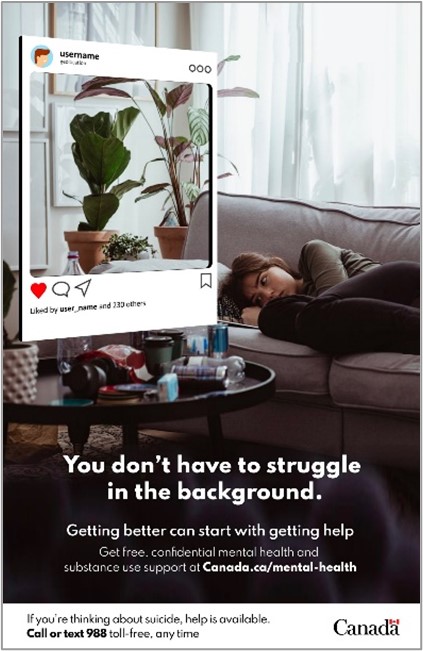
Youth/Young adults 16 to 34 (variation 1)
Woman sitting on the floor in a living room. A social media-style frame in the corner shows a frame on the wall.
You don't have to struggle in the background.
Getting better can start with getting help.
Get free, confidential mental health and substance use support at Canada.ca/mental-health
If you're thinking about suicide, help is available.
Call or text 9-8-8 toll-free, any time.
Canada
Youth/Young adults 16 to 34 (variation 2)
Woman lying on a sofa in a living room. A social media-style frame in the corner shows plants.
You don't have to struggle in the background.
Getting better can start with getting help.
Get free, confidential mental health and substance use support at Canada.ca/mental-health
If you're thinking about suicide, help is available.
Call or text 9-8-8 toll-free, any time.
Canada
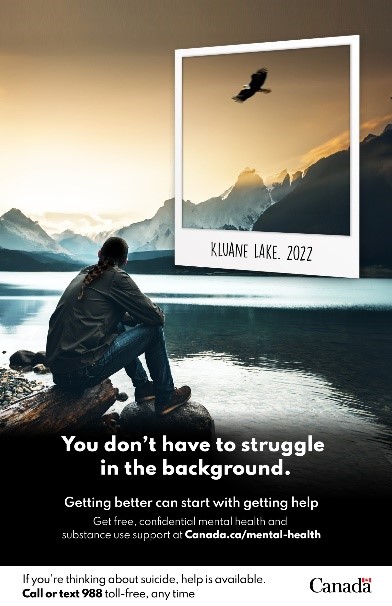
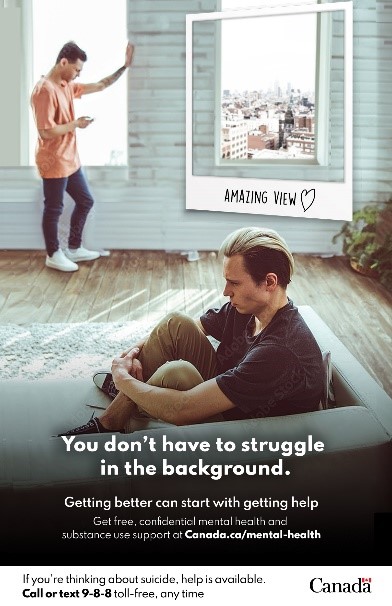
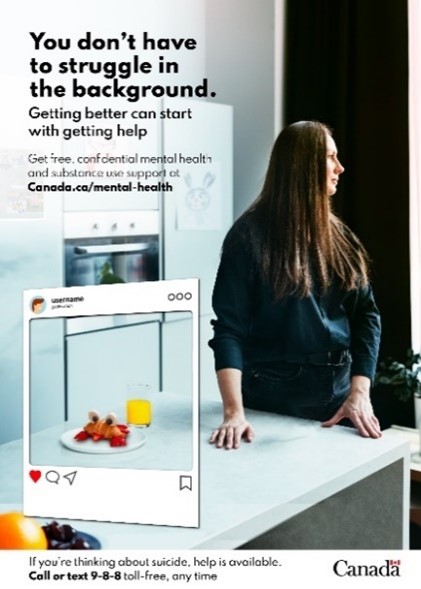

Indigenous Peoples
A man sits on a rock near a stream surrounded by mountains. A social media-style frame in one corner shows a bird and mountains with the words Kluane Lake. 2022.
You don't have to struggle in the background.
Getting better can start with getting help.
Get free, confidential mental health and substance use support at Canada.ca/mental-health
If you're thinking about suicide, help is available.
Call or text 9-8-8 toll-free, any time.
Canada
2SLGBTQI+ individuals
A man sits on a sofa and another he is standing near a window. A social media-style frame in the corner shows a view of a city through a window with the words Amazing view and a heart.
You don't have to struggle in the background.
Getting better can start with getting help.
Get free, confidential mental health and substance use support at Canada.ca/mental-health
If you're thinking about suicide, help is available.
Call or text 9-8-8 toll-free, any time.
Canada
Parents/Caregivers
A woman in a kitchen. A social media frame in the corner shows a croissant with fruit and a glass of orange juice.
You don't have to struggle in the background.
Getting better can start with getting help.
Get free, confidential mental health and substance use support at Canada.ca/mental-health
If you're thinking about suicide, help is available.
Call or text 9-8-8 toll-free, any time.
Canada
Racialized individuals
A man sitting on a sofa. A social media frame in the corner shows plants.
You don't have to struggle in the background.
Getting better can start with getting help.
Get free, confidential mental health and substance use support at Canada.ca/mental-health
If you're thinking about suicide, help is available.
Call or text 9-8-8 toll-free, any time.
Canada

Men aged 35+
A man sitting on a park bench. A photo frame shows a woman and child.
You don't have to struggle in the background.
Getting better can start with getting help.
Get free, confidential mental health and substance use support at Canada.ca/mental-health
If you're thinking about suicide, help is available.
Call or text 9-8-8 toll-free, any time.
Canada
Across the groups, Concept A received moderate to positive scores when asked to provide an initial rating.
This concept was liked most by youth and young adults, men 35 and older, and racialized individuals. It should be noted that the ratings provided by participants are based on the version of Concept A specifically designed for their target audience. The appeal of this concept increased among youth and young adults after the less-hopeful second variation was introduced, and this is reflected in the scores this audience provided in three of the four sessions since the original version was replaced. The appeal of Concept A also increased across all other target audiences on and after November 29 when the second variation was tested, even among men 35 and older and racialized individuals who also appreciated the original designs for this concept. The impact of the alternate version of Concept A on overall concept preferences is further demonstrated later in the report when final votes are discussed.
Those who liked the concept appreciated and understood that the image that one might present to others, often through social media, hides or misrepresents reality.
"I did like it because it. I mean, I think it shows the fakeness that people put online and then it shows that there's more realness behind it a lot of the times. So that's why I gave it an 8." Female, 37, Western Canada, Parents/Caregivers
"I think I'd relate to it. Most people only share good things, including myself." Female, 16, Atlantic Canada, Youth/Young adults
Participants also appreciated the visual aesthetics of the concept, especially when compared to the much more text-focused approach used in the other two concepts. For many, the combination of an impactful image that includes a person or people and a strong headline (You don't have to struggle in the background) helped catch their attention and effectively deliver the message. Being able to clearly see "struggle" through visual elements of the concepts were especially valued if they were easily noticed - this is largely why the second version of the concept for youth and young adults was so widely praised. Key ingredients such as a facial expression, solitude, messiness, a physical demonstration of struggle and hints of substance or alcohol use were key strengths if seen and key weaknesses if not easily noticed. For many, the starker the contrast between what is "in frame" and what is "out of frame", the better.
"I've heard of this referred to as the depression room, where I get into a bit of a slump and the room is a bio-hazard - it's not clean, it's not hygienic. You don't have the energy or the means to do anything about it. This is a light depression room, but it still gets the idea of it across. It shows more of the emotion than the last one did." Female, 24, Atlantic Canada, Indigenous
The impact of the headline was also seen as a strength for some participants, but only if the individual struggling was literally "in the background" in the image used. This was best executed in the second concept designed for youth and young adults and in the concepts for parents/caregivers and for men 35 years of age and older.
Some, especially youth and younger adults, also liked that the concept put social media in focus as a contributing factor to mental health issues. This target audience was most inclined to feel this concept was "relatable." In the execution, it was also important that the social media aspect was immediately recognizable as such. That said, this focus did make the concept somewhat less relevant to participants, especially older ones, who do not use social media much if at all.
Additionally, other design elements were seen as strengths. Participants generally felt that the resources were noticeable and that the overall design seemed professional and polished. The sub-text stating "Getting better can start…" was considered proactive, motivating and does not overpromise on a specific solution or outcome.
The approach was considered to lend itself nicely to a campaign featuring different scenarios. As well, there was some appreciation for the fact that the people featured looked "normal", and that someone does not need to look like their life is in chaos for them to be struggling in some way, and in fact often try to look as "normal" as possible to hide their struggles. This in some ways made the concept more relatable and inclusive.
Those who did not like Concept A as much mostly struggled with the effort needed to understand how the image "in frame" related to the rest of the concept outside the frame. These would be participants who did not immediately understand the basic concept that "reality is not what we show others" through social media, pictures, etc. It also included individuals who did not like the choice of image being selected for the "in frame" part of the visual - for instance, many criticized a focus on mundane items such as plants, a frame on a wall, a croissant sandwich, etc. They would often say that this is not typically what people would post on social media. In the end, many of these participants were left with the impression that they needed to overthink to understand something that needs to be easy to grasp since the ad would be shown on media channels such as social media.
[« The ad is eye-catching. It is modern. But at first glance, it makes you think… IKEA is the first thing that came to my mind, because of the plants. »] - Female, 33, Quebec"La publicité attire l'oeil. Elle est moderne. Mais à un premier plan de vue, ça fait penser un peu…c'est IKEA qui m'est venu en tête avec le concept des plantes."
As noted above, many also felt that the imagery in general was not sufficiently impactful or representative of someone who is struggling - owing to the creatives using stock imagery at this early stage in their development. While it could be assumed, many participants also felt that it could be made more obvious. This was especially the case with parents/caregivers and Indigenous participants, but also for some racialized individuals and men 35 years of age or older. Without a more obvious visual link to mental health, some felt they would not pay attention to the ad.
As much as participants liked the headline, those who liked the overall concept a bit less felt that the character in their concept was not always in the background and that this weakened the effectiveness of the overall concept. In the variation shown to 2SLGBTQI+ participants, the fact that two individuals were featured in the visual caused confusion since participants could not easily decipher who "was in the background". In the end, this compelled some participants across all target audiences to suggest that perhaps the headline should read "You don't have to struggle alone" and some of the 2SLGBTQI+ participants specifically to suggest removing one of the characters.
"I do kind of understand where they're trying to go, but I just think the execution didn't hit the mark for me. […] He shouldn't be in the foreground if they're talking about "You don't have to struggle in the background" - the background here, actually that's the part that's showing the positivity." Male, 37, Ontario/Nunavut, Racialized individuals
Some also felt the concept focused too much on mental health exclusively and did not adequately capture struggles related to substance or alcohol use. On this matter, many appreciated the new approach taken to the youth and young adults concept because it lends itself nicely to featuring pill and alcohol bottles on the messy table. Many of those commenting on other variations of Concept A also made suggestions to integrate alcohol somewhere in the scenery, such as a glass of wine in the mother's hand in the concept for parents/caregivers, or a brown paper bag in the hands of the father in the concept for men 35 years of age or older.
As much as an image can immediately capture someone's attention, the choice of image can alienate members of the target audience or leave them feeling they are not part of the target audience. For instance, this sentiment came through among men 35 years of age or older who do not have children or who are not married, and among female parents/caregivers who felt that the kitchen shown in their concept was not very realistic, especially for someone who is struggling with their mental health. Similarly, male parents/caregivers could not easily relate to the female character in their concept.
Other notable weaknesses for Concept A included:
In the end, few seemed to feel that the concept they were shown accurately reflects mental health, substance use and suicide in Canada. Although the second version of the youth and young adult concept succeeded the most on this front, most felt that the concepts seemed more focused on mental health and less on substance use and suicide. Adding bottles or glasses of alcohol, recreational drugs, pills, etc., would help increase how well the concept could address substance use. Many also felt that the concept would better reflect all three areas by making all the resources, including the 9-8-8 number, more prominent.
That said, not all participants were convinced that the concept should try to address all three issues together. There were concerns raised in some groups that the ad suggests that the three issues are necessarily linked, whereas they feel that they can often be separate issues. Others felt that it was trying to do too much, which could result in the audience being confused or not remembering either of the resources. Future ad campaigns could consider treating these subjects in separate creatives and/or as separate campaigns.
Many participants felt that the main message was to bring to their attention that help for mental health is available in general or that "we" (the Government of Canada) are here to help. Others also sensed that the main message was to help them appreciate that what is shared with the world, especially through social media, does not always reflect what is really happening behind the scenes and that people should seek help rather than pretend or hide. Some also felt that the main message encouraged people to seek help if they need it and to not struggle "in the background" or alone. A few other interpretations of the main message included:
For the most part, participants felt the concept was encouraging people to get help or seek out resources if it was needed. Many others felt the concept was alerting them to the fact that resources such as a website and a telephone number are available. Otherwise, participants felt the ad was encouraging them to step out from the background or the shadows, to be genuine and to focus on self-care.
Participants were asked for suggestions on how they would change their concept to better convey a sense of urgency and to encourage people to seek help early. Suggestions included the following:
In addition to the general comments outlined above, the following comments regarding visual elements or text were received for each audience-specific variation.
In the groups with youth and young adults aged 16-34, when shown the first variation of the concept, participants felt that the concept could be improved by making the background appear messier, as some felt that it felt too clean and stages. Additionally, some suggested that the main character could be shown in bed or on public transportation.
The following suggestions were made for other variations of this concept:
Some participants in the groups with men aged 35 and older felt that the 9-8-8 number was not very noticeable.
From a visual standpoint, it was suggested that the animation could show the man returning back into the frame.
The topic of divorce was said to be an important challenge for this target audience.
In groups with this target audience, the following suggestions were made for other variations of this concept:
Regarding the visuals, some felt that the person should be more clearly sad and struggling. It was suggested that this could be done by showing the person's face and body language, so it is easier to see that he is in distress.
Additionally, participants in this target audience agreed that the image should look more like a social media post on a smartphone rather than a polaroid picture.
Other suggestions regarding the visuals included:
Regarding the text elements of Concept A, Indigenous participants felt that the ad should promote that the resources can be used by someone they know. There was interest in using the text from Concept B instead and using the word "healing". It was also suggested to make the phone number more prominent
In groups with this target audience, the following suggestions were made for other variations of this concept:
Participants from the 2SLGBTQI+ community shared several areas where the concept could improve from a visual standpoint.
Firstly, it was suggested that the concept should make it more obvious that the image is a social media post on a smartphone, such as by including a number of "likes". The image was said to look more like a polaroid picture.
Among this target audience, many felt that the visuals of the ad should show more contrast between real life and the posted life. Some of the suggestions on how this could be done included:
Participants felt that the visual does not necessarily have to show two men or a same-sex relationship in order to appeal to the 2SLGBTQI+ community. They felt that it would be better if it had broader appeal
Additionally, it was suggested to replace the text "in the background" with "in silence" or "alone".
When considering potential variations of this concept, the following suggestions were made:
In groups with parents and caregivers, participants thought that the concept should show a greater sign of struggle in the overall visual. Some suggested showing a messy background, messy counters, things you would not post in Instagram, a work-related scene or kids running around.
Some also felt that the idea of a "before and after" of trying to get a curated family photo could fit well with this concept.
From a text standpoint, participants thought that the words "free" and "anytime" should be more prominent
When shown the alternative option for concept C, the following suggestions were made:
In groups with this target audience, the following suggestions were made for other variations of this concept:
In groups with racialized individuals, participants offered several visual suggestions.
A possible animation idea was suggested to show the character responding to a text asking how they are doing - they start by typing "it is not going well" then deletes this before sending and types "it is going well."
Additionally, it was suggested that the social media post should show a high number of "likes" and a caption.
Other suggestions for visual improvements included:
In groups with this target audience, the following suggestions were made for other variations of this concept:
For this concept, a variation unique to each target audience was tested except for parents/caregiver and for racialized individuals who shared the same concept.


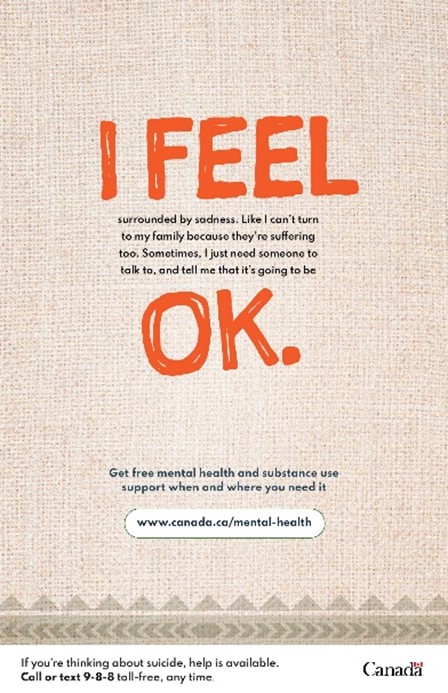
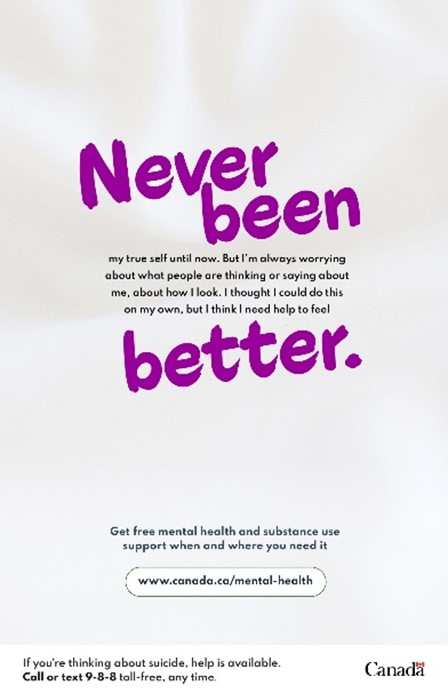
Youth/Young adults 16 to 34
I'm having a hard time coping. I have no clue what to do after grad. It makes me so anxious I could be sick. If I could just talk to someone who understands, I could finally start to chill.
Get free mental health and substance use support when and where you need it https://www.canada.ca/mental-health
If you're thinking about suicide, help is available.
Call or text 9-8-8 toll-free, any time.
Canada
Men aged 35+
I am actually struggling right now. I can't stand thought at looking weak. But it's time to do something about it, and stop pretending everything's good.
Get free mental health and substance use support when and where you need it https://www.canada.ca/mental-health
If you're thinking about suicide, help is available.
Call or text 9-8-8 toll-free, any time.
Canada
Indigenous Peoples
I feel surrounded by sadness. Like I can't turn to my family because they're suffering too. Sometimes, I just need someone to talk to, and tell me that's going to be ok.
Get free mental health and substance use support when and where you need it https://www.canada.ca/mental-health
If you're thinking about suicide, help is available.
Call or text 9-8-8 toll-free, any time.
Canada
2SLGBTQI+ individuals
Never been my true self until now.But I'm always worrying about what people are thinking or saying about me, about how I look. I thought I could do this on my own, but I think I need help to feel better.
Get free mental health and substance use support when and where you need it https://www.canada.ca/mental-health
If you're thinking about suicide, help is available.
Call or text 9-8-8 toll-free, any time.
Canada
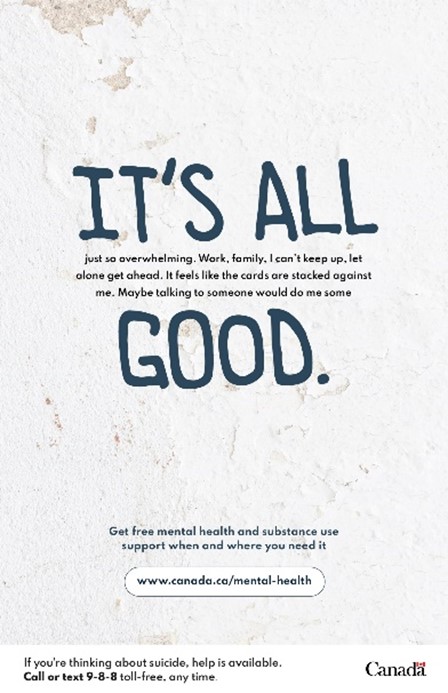
Parents/Caregivers; Racialized individuals
It's all just so overwhelming. Work, family, I can't keep up, let alone get ahead. It feels like the cards are stacked against me. Maybe talkin to someone would do me some good.
Get free mental health and substance use support when and where you need it https://www.canada.ca/mental-health
If you're thinking about suicide, help is available.
Call or text 9-8-8 toll-free, any time.
Canada
Overall, Concept B received moderate scores.
This concept performed best in groups with Indigenous Peoples followed by men aged 35 and older.
Those who liked the concept enjoyed the simple approach. The small print "inner dialogue" was liked by many and was seen as accurate and relevant as well as intriguing. The "voiceover" approach was also appreciated, particularly because it made the ad more accessible. Some also mentioned enjoying the first-person perspective. Participants felt that the concept reflected how things can look different beyond the surface and that how people portray themselves or how they initially and often automatically tell others about how they are feeling may not actually reflect how they are truly feeling.
The concept was thought to work well as a poster, for example at a bus stop or subway platform where people would have time to read it.
Those who did not like Concept B as much felt that while the idea was good, it lacked visual appeal. Specifically, the font and backgrounds used lacked creativity and were a bit bland. Some also felt that there was too much text in the middle section. Some participants did not enjoy the text-only approach and would prefer to see some visuals. Others felt that the small text was not relatable to them as it appeared too focused on specific experiences or scenarios.
Since the concept does not immediately reference mental health and there are no images, there were concerns that this concept would not perform well on social media as many people scroll with their phones muted or will not take the time to read the small font as the text-only approach is not as eye-catching.
"If this was coming up in my feed and I'm looking through, I'd see "It's all good" and I just keep moving on. So, you've already lost me." - Male, 52, Atlantic Canada, Parents/Caregivers
Some other suggestions included:
Participants felt that the main message was reminding the audience that many people struggle with mental health issues even if they do not talk about it. It reminded the audience that the way they are feeling is normal and they should not be ashamed. The ad was seen as encouraging individuals to express their feelings and not feel that they have to suppress things if they are struggling. As well, participants felt that Health Canada was saying they are there for support and there are resources available.
The call to action was said to be to seek help if you are struggling by using the provided government resources. Some felt that it told the audience to stop and think about how they are really feeling.
Several participants in the groups with youth and young adults aged 16-34 felt that the message was relatable, particularly the idea of not knowing what the future holds.
On the other hand, while some could relate to the mention of graduation, many in this age bracket could not and thus felt that it was too focused on a younger audience.
[« I like the idea that from afar, things seem good, but when we get up close, some things are hidden.Personally, I cannot relate since I am not a student. »] - Male, 33, Quebec, young adult aged 16-34 "J'aime le concept que de loin on a l'impression que ça va bien mais que quand on se rapproche, il y a des trucs cachés. Mais moi ça ne me parle pas en tant que personne qui n'est pas étudiant."
In the English groups, the phrase "I'm chill" received mixed reactions, with some enjoying it while others felt that it did not reflect the way they would speak. It also lacked seriousness to some.
A few did not like that the concept implied that just talking to someone about mental health could resolve these issues.
Some suggestions for alternative text included replacing graduation with burnout, work, finances, job loss, uncertainty of where to go in life, personal relationships (family, love, friends, etc.), or substance use/alcohol.
Many Indigenous participants felt that this concept was relatable. Some could resonate to the message about family and intergenerational trauma, while others mentioned connecting with the feeling of being ashamed about their struggles and feeling like they could not talk about these issues with others.
Despite several participants connecting with the specific experiences mentioned, some felt that the message could be broadened so that it connects with a broader audience. It was suggested that the concept could add text such as "I feel like I can't talk to anyone" / "I don't have anyone to talk to," which would give it a broader appeal.
Some were concerned that the message conveyed a false promise that talking to someone would make things okay as they felt that the available resources might not deliver as promised.
The visual aspect of the concept received mixed reactions. Some enjoyed the colour overall look and feel while others felt that there could be improvement. The use of the colour orange was suspect to some to be potentially targeting Indigenous Peoples, which others felt this was singling them out as the only ones who are suffering.
The overall message resonated with many participants who belong to the 2SLGBTQI+ community.
The headline was thought to be catchy and attention grabbing as most people do not relate to the phrase "never been better" which might intrigue them to read on.
"I kinda feel the same way about it being like intriguing when it says never been better, because if I was watching it I would be like, well… they're gonna tell me how I can be better, and I'd like to be better. So let's see where it goes and what happens." - Male, 44, Atlantic Canada, member of the 2SLGBTQI+ community
However, the additional text received some mixed feedback. Many felt that the words "never been myself until now" seemed disconnected with the rest of the text and the overall message as the "until now" part does not imply a mental health struggle (but rather the opposite, or a resolution of something that they may have struggled with in the past). Additionally, there was some criticism over the use of the words "how I look," with the focus on vanity being said to be very specific to a small (younger) audience or it turning participants off as they were not sure they agreed with the general idea that self-esteem was a big issue. It was suggested that "how I look" could be removed and left at "worrying about what people are thinking or saying about me."
Some suggestions for alternative text included: addiction, financial issues, work-life balance, world or political issues, life direction, the environment, fake news, polarized and aggressive opinions, or marital abuse.
Among the groups with parents and caregivers, some participants enjoyed Concept B and found it relatable. The text-only approach was said by some to pull them in; however others found this approach to be boring and suggested that some visuals could be added.
Some suggestions for alternative text included interest rates, inflation, cost of living, personal finances, social media pressures (feeling you need to keep up) and uncertainty of their kids' future.
While many participants who were from racialized communities enjoyed the message and could resonate with it or found the concept appealing, they also offered some criticism.
Some participants felt that the overall visual appeal was lacking and could use more colour. It was also said to benefit from having an image of a person included.
Additionally, it was brought up that the phrase "cards stacked against me" (in the English version) may be confusing to those who do not speak English as their first language.
Some suggestions for alternative text included work-life balance, personal relationships, meeting family expectations, financial struggles, paying bills, cost of living, interest rates, access to healthcare or staying healthy.
Participants in the groups with men aged 35 and older reacted fairly positively to the overall message conveying how someone might really feel below the surface. The call to action "time to do something about it" was appreciated.
While the reference to pretending things are good was relatable to men, the reference to feeling vulnerable was not received as positively. Some explained that saying "I'm good" is more of a habitual thing rather than a concern about appearing vulnerable.
[« It's not necessarily vulnerability that brings you to say, 'I am well', it's just simpler. »]-Male, 35, Quebec, Men aged 35+ "Ce n'est pas nécessairement la vulnérabilité qui t'apporte à dire « je me sens bien » mais plutôt c'est juste plus simple."
Some also suggested that the text could be more direct and simply read as: "Tu ne te sens pas bien?" rather than being subtle and indirect. Additionally, some did not like the words "I can't stand the thought of looking weak".
Visually, the wood paneling background seemed weird and irrelevant to some; they suggested that it looked like an ad for a hardware store.
Some suggestions for alternative text included the mention of work or stress.
For this concept, all audiences were shown the same concept, followed by an alternative coloured version:
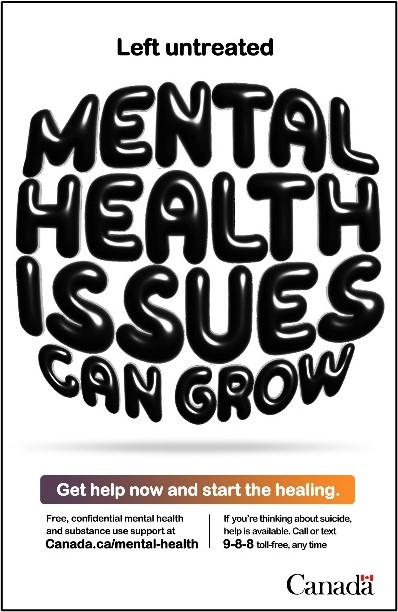
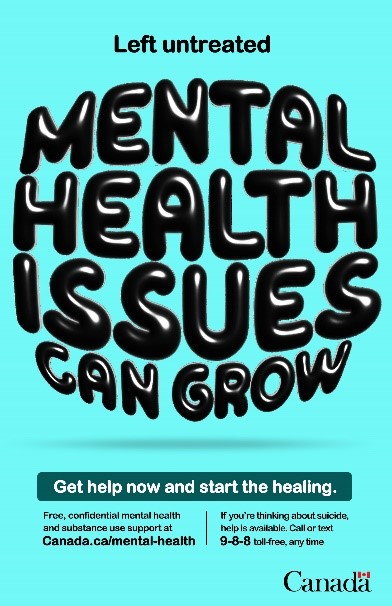
Regular version
Left untreated mental health issues can grow
Get help now and start healing.
Free, confidential mental health and substance use support at Canada.ca/mental-health
If you're thinking about suicide, help is available. Call or text 9-8-8 toll-free, any time.
Canada
Alternative version
Left untreated mental health issues can grow
Get help now and start healing.
Free, confidential mental health and substance use support at Canada.ca/mental-health
If you're thinking about suicide, help is available. Call or text 9-8-8 toll-free, any time.
Canada
Across the groups, Concept C received moderate scores.
This concept was liked most by members of racialized communities, parents and caregivers and members of the 2SLGBTQI+ community.
Those who liked the concept appreciated the clear, straightforward and easy to understand nature of the message. Participants felt that they did not need to think about what the concept was trying to say, as the topic was clearly about mental health. The message that mental health issues can worsen or grow if not treated was deemed to be true and to many, relatable.
"It was straightforward, right to the point.It says what it means. Mental health issues can grow. So, if you're struggling or are feeling that way, you get help now and right below. I thought it was clear, concise." - Male, 52, Atlantic Canada, Parents/Caregivers
In the English groups, many liked the directness of the words "get help now" which implied a sense of urgency in the message and gently reminded the reader not to suppress mental health issues. There was also some appreciation of the use of the word "healing."
"The tagline: Get help now and start the healing. The healing is what definitely got to me." - Male, 37, Ontario, member of a racialized community
From a visual perspective, many felt that the font worked well with the message and was eye-catching and creative. Several participants could imagine how the concept could be creatively portrayed as an animation with popping balloons/letters.
Those who did not like Concept C as much felt that the creative aspect seemed a bit childish or gimmicky considering the serious and important topic. Others said that the idea of "healing" was over-promising and not realistic given that many mental health issues are not something that needs to be or can be healed, but rather are something that people learn to live with.
"It implies that mental health is treatable in the sense that it will go away. Mental health issues are many and some can go away and many never go away." - Male, 67, Western Canada, Indigenous Person
Some participants felt that, from a visual standpoint, colour and images were lacking and overall seemed cheesy or bland. This made the concept less memorable and less likely to stand out from other ads about mental health. Specifically, the balloon style font and colours used were said by some to be childish and not very appealing, and reminded some of other ads they had seen that used this type of metaphor or letter type. As well, many felt the words "left untreated" got lost among the other text or were not connected properly to the main text. More visuals rather than text-only would be appreciated for this concept.
A few of the youth/young adults felt that the concept was trying to target a younger audience, which was seen as less relevant.
Some other suggestions included:
Overall, feedback for Concept C was quite consistent across the target audiences.
Participants felt that the main message was that mental health issues may start small, but they can grow to be much larger and more urgent. Furthermore, the message alluded to the idea that individuals need to recognize when they are struggling. Some felt the Government of Canada was telling the audience that they have support for them.
The call to action was said to be that individuals should not wait as issues could get extreme if they fester or build up. It informed the audience about available resources provided by the government and encouraged those suffering to seek the help that they require as soon as possible.
When participants were asked to consider the alternative version which contained a blue background, reactions were mixed. Some felt that the blue background was more eye-catching and provided more contrast whereas the black and white was more boring. A few suggested that adding colour such as red in the font could further improve the visual appeal.
On the other hand, some preferred the black and white concept, suggesting that the blue seemed a bit more childish and lacking seriousness, comparing it to something that could be seen on a high-school poster. The blue colour did not seem appropriate for an advertisement targeting individuals who are already struggling. The black and white version was said to convey a more serious tone without being depressing.
The side-by-side layout of the mental health resources was thought to be best in this concept.
Overall, the resources included in the concept were considered "good to have." Some felt that they could see themselves visiting the website or seeking a self-assessment.
After evaluating each concept separately, a brief discussion was held to identify which concept participants felt was the most effective.
While preferences varied slightly across the individual target audiences, overall, the concept most often chosen as the winning concept was Concept A (Out of Frame), with the other two concepts tied in second place at quite some distance. This concept was particularly appealing to youth and young adults, Indigenous Peoples, members of the 2SLGBTQI+ community, parents and caregivers, and men aged 35 and older.
Moreover, when participants were asked to consider the alternative version of Concept A rather than the primary one they had been shown, in all groups and across segments, several participants said that they would switch their vote from Concept B or C to this alternate Concept A, mainly because they felt it was better executed than the original and because it spoke more to them and to the topic of mental health struggles.
Concept B (Honest Answer) and Concept C (Bigger) were also chosen by a fair number of participants as their top choice. Concept B was particularly appealing to Indigenous Peoples where it often was in a virtual tie with Concept A.
Concept C (Bigger) tended to be selected more as the preferred concept by members of racialized communities (chosen more often among this group than Concept A), by parents and caregivers (in a virtual tie with Concept A among this group), and by members of the 2SLGBTQI+ community (a close second after Concept A).
Those who chose Concept C were asked specifically why they preferred it. Among those who preferred Concept C, the concept was generally praised for being simple, straightforward and demonstrating a sense of urgency.
Participants who selected Concept C as their top choice often felt that the reference to mental health was immediately apparent, and they felt that the message and idea that these issues can "grow" was simple to understand, did not require the audience to overthink, and is both important and true. It was said to have more of a sense of urgency in the call-to-action text, which encourages the audience to seek care or use the presented resources as soon as they can. In the English groups, it was pointed out that they particularly appreciated the directness of the words "get help now" and the connection they felt to the term "healing" in text. Those who preferred Concept C also felt that it was relevant to a broader audience, which was often felt to a lesser extent with the other two concepts.
Visually, the concept was said to be appealing as the image was not overly busy but rather "short and sweet" and worked well with the animation. While some felt that the black and white concept was stark and eye-catching, the blue background was also appealing for many. Some who preferred this concept also shared that it had the best layout of the information about mental health resources with the side-to-side text easy to see and the bolded website and phone numbers featured prominently next to each other.
Participants were also asked about the mental health resources that were shared in the concepts (the website as well as the new 9-8-8: Suicide Crisis Helpline).
Many participants agreed that they would remember the 9-8-8 phone number. If the number was shared a lot across various messages from the government, participants suspected that this would increase recall and the number would become part of most people's consciousness, similar to 911 or the number of the Kids Help Phone.
The website would have much less recall for a few reasons. For most, it was not seen as a memorable URL (not short or punchy or different from other Government of Canada websites), and the inclusions of the forward slash and the hyphen compounded this idea. However, several participants suggested that they would probably use Google and search "mental health Canada" in order to find the website if they needed to.
As well, many participants could see themselves sharing these resources with a friend, although they would not necessarily share the advertisements themselves. Most of these participants explained that they would likely explore the resources themselves before sharing them as they would want to feel equipped to discuss it and would want to know what they were referring their friends to. Because of this, there were requests for more information about the 9-8-8 number, such as how it works, who is on the other side of the line, and what type of information or help one could expect to get.
Some participants suspected that including two types of resources provides flexibility to those who are struggling, as some may not feel comfortable directly speaking to a person they do not know, while others may need that type of support, may appreciate sharing anonymously with someone they don't know, or would not be able to effectively use a website to navigate the system. A few also imagined scenarios where the text option would benefit someone in a mental health crisis who was unable to talk on the phone (for example, if they had kids nearby, or if they were at school or at work). It was suggested that the website should include a chat function for receiving support for individuals who are not comfortable talking but do not enjoy texting.
Many participants understood that the new 9-8-8 helpline would be intended for more immediate, urgent help and for suicide prevention, while the website would be useful for long-term planning or non-urgent mental health and substance use matters and may include things such as mental health tips and lists of provincial or regional resources. Some perceived that the website may be more for caregivers or supporters of those with mental health issues while the phone number would directly serve those suffering from a mental health issue. A few participants felt that the approach of sharing both resources was a bit confusing once they noticed that the 9-8-8 helpline was intended for situations of crisis whereas they figured the website and phone number would serve the same objective. Here again, there was some ask for more information about the 9-8-8 phone number and what type of help it would provide, by whom, and how.
[« The question I always ask myself about those numbers dedicated to urgencies is: Is my situation urgent enough to call that number? Is the person at the other end going to really care?Will I annoy them? »] - Male, 35, Quebec, Men aged 35+ "La question que je pose toujours avec ces numéros-là, qui sont vraiment dédiés à l'urgence, c'est : Est-ce que mon cas est assez urgent pour appeler ce numéro-là? Est-ce que la personne que j'ai en face de moi, est-ce qu'elle va vraiment m'avoir à cœur? Est-ce que je vais pas la déranger?"
Participants felt that the advertisements should make it clear that the helpline is secure and confidential, particularly as there are those who instinctively feel that anything associated with the Government of Canada may not be. There were also some who suggested that 9-8-8 should receive its own advertisement campaign to build more awareness without being "clouded" by the message about the website. It was suggested that an awareness campaign should try to reach kids and young adults so that it would become part of the Canadian psyche, much as 9-1-1 or the Kids Help Phone numbers are.
There were a few concerns shared regarding these resources. A few shared concerns or were skeptical about the fact that the Government of Canada is behind the resources as they recalled their own negative experiences with other government services. Some felt that they would not necessarily turn to a federal website if they required mental health support but instead would seek a local resource. There were also concerns over how substance use disorders and addiction may fit into the resources as it seems unclear whether these types of issues would warrant a call or whether the 9-8-8 phone number would be appropriate for people struggling with substance use issues, whether acute (i.e., overdose situations) or chronic. It was sometimes suggested that this part of the message should not be included because it begged more questions than that it gave useful information.
After discussing the advertising concepts, participants were asked to provide feedback on two alternative calls to action referencing the 9-8-8 helpline. Version 1, below, was the one used in all the concepts during the discussion, while Version 2 was discussed as an alternative approach:
The second approach was preferred by most participants. Those who preferred the second approach believed it came off as more inclusive as it broadens the scope of who can call the helpline from only those thinking about suicide to include also those in an emotional crisis. It was said to encourage individuals to seek help earlier. The language was also considered more direct and often appreciated because it was shorter. Particularly, some said that "toll-free" was antiquated and should not be mentioned.
Alternatively, those who preferred Version 1 often liked the explanatory language used, (help is available) and liked that it was clear that the helpline is free and can be used any time. These participants often would like to this language used in Version 1 added to Version 2. Those who preferred this original version also said that they felt the phone lines should be kept for those who needed it most and that by broadening the scope as suggested in Version 2, it may not be able to effectively help those who needed it the most. Some who preferred Version 1 stated that they would prefer Version 2 if the word "crisis" could be softened, such as using the word "distress" or similar.
Time permitting, the discussions closed on a general exploration of mental health-related topics, including mental health resources.
While not explicitly explored with participants, some alluded to their own past and present mental health struggles, or of those of their loved ones. For many, there is or would be little hesitation in finding and using mental health resources if they felt they needed support.
However, the notion of stigma and ego or emotional state getting in the way of seeking help was brought up a few times.
[« I tried to get information about mental health support, but I was afraid of what others would think about me. I told myself, wow, someone might see me there and think I am stressed. If I say I am anxious, what will people think of me? »] - Female, 42, Quebec, member of a racialized community"J'ai parfois tenté de me renseigner pour des soutient en santé mentale mais j'avais eu peur du regard des autres. Je me suis dit 'wow, on va peut-être me voir là et penser que je suis en train de stresser.' Si je dis que je fais de l'anxiété, quel est le regard qu'on va apporter sur moi."
That being said, only very few participants said that they had at some point in their lives thought about looking for resources for their mental health struggles but had then decided not to do so. The few participants who spoke of having this experience mostly said that this was in their early 20s when they were in university, and that at that time, they felt that they should just "power through" or "take the lows with the highs" rather than reaching out or finding more information.
Wait times and access to mental health services in Canada were often mentioned as barriers to receiving mental health care, especially in more rural and remote areas. This would deter some participants from even looking for help altogether.
[« Waiting lists are very long in the public system. »] - Female, 47, Quebec, member of a racialized community "Les listes d'attentes sont tellement longues dans le public."
Cost was also brought up as a barrier in some groups. Those who had employer-provided mental health resources often said those were more accessible and they would try to go there first.
When discussing using the 9-8-8 phone number as a resource, there was some sense that if they were in crisis, participants would potentially call, but that it would likely not be their first way of seeking help. In this context, some shared views about the pros and cons of speaking to someone they did not know and who did not know them, versus building a relationship with a mental health professional in a more traditional therapy setting. There was also a sense that participants wanted to know more about how the service works and what they could expect when calling before feeling comfortable using it.
While many said they had no questions or concerns about the help line, there were specific questions and concerns about confidentiality or tracking of personal information, user-friendliness, wait times and employee training and competencies. It was suggested that if primary caregivers or other mental health professionals in the community would provide their patients with information about the phone number and the website, this could help provide legitimacy and assuage some doubts people might have.
Some said that they would typically not seek help with their mental health from the federal government, while others said that the fact that this was a government-run service legitimized it for them. These participants often also expressed appreciation for the federal government putting their money where their mouth is on this topic, and they applauded the launch of the service.
The hopes or expectations for the service for it to be effective included that there would be a quick response time, whether by phone or text, that both modes would be answered by live responders, and that assistance would be local. It was also brought up that responders should be trained in cultural sensitivity or provide services tailored to certain groups, such as language minorities and Indigenous Peoples. There was also the hope that the whole service would be and would remain free, rather than quickly referring callers to a service that would be expensive.
Generally, participants hoped that they would be speaking to a mental health expert or trained therapist rather that to someone who would serve as a referral system. In a number of groups, participants asked whether there was a connection between 9-8-8 and 9-1-1, and whether emergency services would be called if it became apparent that a caller was either inflicting or close to inflicting self-harm or harm to others.
Typically, when told a bit more about how the service is designed and how it works, it met these expectations.
All research work was conducted in accordance with the professional standards established by the Government of Canada Public Opinion Research Standards, as follows:
Quorus was responsible for coordinating all aspects of the research project including working with Health Canada in designing and translating the recruitment screener and the moderation guide, coordinating all aspects of data collection logistics, including participant recruitment, providing the online focus group platform and moderating all focus groups and delivering required reports at the end of data collection. The research approach is outlined in greater detail below.
The target audience for this research study consisted of Canadians from the following regions:
Six groups were held in each region, with one group dedicated to each of the following segments:
In the design of the recruitment screener, specific questions were inserted to clearly identify whether participants qualified for the research program and to ensure, where applicable, a good representation by age, region, gender, ethnicity.
In addition to the general participant profiling criteria noted above, additional screening measures to ensure quality respondents include the following:
Data collection consisted of online focus groups with individuals in Canada. Each focus group lasted approximately 90 minutes.
For each focus group, Quorus recruited 8 participants with the goal of achieving 6-8 participants per session. All individuals who participated in a focus group received an honorarium of $125.
Participants invited to participate in the focus groups were recruited by telephone through random digit dialing of the general public as well as through the use of a proprietary opt-in database.
The recruitment of participants followed the screening, recruiting and privacy considerations as set out in the Standards for the Conduct of Government of Canada Public Opinion Research-Qualitative Research. Furthermore, recruitment respected the following requirements:
At the recruitment stage and at the beginning of each focus group, participants were informed that the research was being conducted for the Government of Canada and Health Canada. Participants were informed of the audio/video recording of their session and of the presence of Health Canada observers. Quorus ensured that prior consent was obtained at the recruitment stage and before participants began their focus group.
All sessions were conducted in the evening after regular business hours. The research team used the Zoom platform to host and record focus group sessions (through microphones and webcams connected to the moderator and participants electronic devices, such as their laptop, tablet or smartphone) enabling client remote viewing.
| Date | Time (EST) | Region | Segment | Language | Number of participants |
|---|---|---|---|---|---|
| November 27, 2023 | 4:00 PM | Atlantic Canada | Parents/Caregivers | English | 7 |
| 6:00 PM | Ontario/Nunavut | Men 35+ | English | 7 | |
| 8:00 PM | Western Canada | Youth/Young adults 16 to 34 | English | 7 | |
| November 28, 2023 | 5:00 PM | Ontario/Nunavut | 2SLGBTQI+ individuals | English | 7 |
| 5:00 PM | Quebec | Youth/Young adults 16 to 34 | French | 6 | |
| 7:00 PM | Quebec | Men 35+ | French | 8 | |
| 8:00 PM | Western Canada | Parents/Caregivers | English | 5 | |
| November 29, 2023 | 5:00 PM | Quebec | Racialized individuals | French | 8 |
| 7:00 PM | Quebec | Parents/Caregivers | French | 5 | |
| 8:00 PM | Western Canada | Men 35+ | English | 7 | |
| November 30, 2023 | 5:00 PM | Ontario/Nunavut | Racialized individuals | English | 6 |
| 8:00 PM | Western Canada | 2SLGBTQI+ individuals | English | 8 | |
| 5:00 PM | Quebec | Indigenous Peoples | French | 6 | |
| 7:00 PM | Quebec | 2SLGBTQI+ individuals | French | 7 | |
| 9:00 PM | Western Canada | Racialized individuals | English | 8 | |
| December 2, 2023 | 1:00 PM | Ontario/Nunavut | Parents/Caregivers | English | 8 |
| 3:00 PM | Atlantic Canada | Men 35+ | English | 7 | |
| 10:00 AM | Atlantic Canada | Racialized individuals | English | 7 | |
| 4:00 PM | Atlantic Canada | Youth/Young adults 16 to 34 | English | 8 | |
| December 4, 2023 | 5:00 PM | Atlantic Canada | 2SLGBTQI+ individuals | English | 8 |
| 7:00 PM | Ontario/Nunavut | Indigenous Peoples | English | 7 | |
| December 5, 2023 | 4:00 PM | Atlantic Canada | Indigenous Peoples | English | 7 |
| 6:00 PM | Ontario/Nunavut | Youth/Young adults 16 to 34 | English | 8 | |
| 8:00 PM | Western Canada | Indigenous Peoples | English | 7 | |
| TOTAL: 169 | |||||
Qualitative research seeks to develop insight and direction rather than quantitatively projectable measures. The purpose is not to generate "statistics" but to hear the full range of opinions on a topic, understand the language participants use, gauge degrees of passion and engagement and to leverage the power of the group to inspire ideas. Participants are encouraged to voice their opinions, irrespective of whether or not that view is shared by others.
Due to the sample size, the special recruitment methods used, and the study objectives themselves, it is clearly understood that the work under discussion is exploratory in nature. The findings are not, nor were they intended to be, projectable to a larger population.
Specifically, it is inappropriate to suggest or to infer that few (or many) real world users would behave in one way simply because few (or many) participants behaved in this way during the sessions. This kind of projection is strictly the prerogative of quantitative research.
NOTE 1: As participants may qualify for multiple sessions, recruitment should prioritize lower incidence segments first.
NOTE 2:All participants should be 18 years of age or older except for those recruited for "Youth and young adults 16 to 34" where the lowest age can be 16.
|
Group 1 Parents/Caregivers |
Group 2 Men 35+ |
Group 3 Youth/Young 16 to 34 |
Group 4 2SLGBTQI+ individuals |
|---|---|---|---|
|
November 27 5:00 pm AST Atlantic Canada |
November 27 6:00 pm EST Ontario/Nunavut |
November 27 5:00 pm PST Western Canada (SK/MB/AB/BC/NWT/YK) |
November 28 5:00 pm EST Ontario/Nunavut |
|
Group 5 - FRENCH Youth/Young 16 to 34 |
Group 6 - FRENCH Men 35+ |
Group 7 Parents/Caregivers |
Group 8 - FRENCH Racialized individuals |
|
November 28 5:00 pm EST Quebec |
November 28 7:00 pm EST Quebec |
November 28 6:00 pm PST Western Canada (SK/MB/AB/BC/NWT/YK) |
November 29 5:00 pm EST Quebec |
|
Group 9 - FRENCH Parents/Caregivers |
Group 10 Men 35+ |
Group 11 Racialized individuals |
Group 12 2SLGBTQI+ individuals |
|
November 29 7:00 pm EST Quebec |
November 29 6:00 pm PST Western Canada (SK/MB/AB/BC/NWT/YK) |
November 30 5:00 pm EST Ontario/Nunavut |
November 30 5:00 pm PST Western Canada (SK/MB/AB/BC/NWT/YK) |
|
Group 13 - FRENCH Indigenous Peoples |
Group 14 - FRENCH 2SLGBTQI+ individuals |
Group 15 Racialized individuals |
Group 16 Parents/Caregivers |
|
November 30 5:00 pm EST Quebec |
November 30 7:00 pm EST Quebec |
November 30 6:00 pm PST Western Canada (SK/MB/AB/BC/NWT/YK) |
December 2 1:00 pm EST Ontario/Nunavut |
|
Group 17 Men 35+ |
Group 18 Racialized individuals |
Group 19 Youth/Young 16 to 34 |
Group 20 2SLGBTQI+ individuals |
|
December 2 4:00 pm AST Atlantic Canada |
December 2 11:00 am AST Atlantic Canada |
December 2 5:00 pm AST Atlantic Canada |
December 4 6:00 pm AST Atlantic Canada |
|
Group 21 Indigenous Peoples |
Group 22 Indigenous Peoples |
Group 23 Youth/Young 16 to 34 |
Group 24 Indigenous Peoples |
|
December 4 7:00 pm EST Ontario/Nunavut |
December 5 5:00 pm AST Atlantic Canada |
December 5 6:00 pm EST Ontario/Nunavut |
December 5 5:00 pm PST Western Canada (SK/MB/AB/BC/NWT/YK) |
A. Introduction
Hello/Bonjour, my name is [NAME] and I am with Quorus Consulting Group, a national public opinion research company. We're planning a series of online discussion groups on behalf of the Government of Canada with people in your area. Would you prefer to continue in English or French? / Préférez-vous continuer en anglais ou en français?
[INTERVIEWER NOTE: FOR ENGLISH GROUPS, IF PARTICIPANT WOULD PREFER TO CONTINUE IN FRENCH, PLEASE RESPOND WITH, "Malheureusement, nous recherchons des gens qui parlent anglais pour participer à ces groupes de discussion. Nous vous remercions de votre intérêt." FOR FRENCH GROUPS, IF PARTICIPANT WOULD PREFER TO CONTINUE IN ENGLISH, PLEASE RESPOND WITH, "Unfortunately, we are looking for people who speak French to participate in this discussion group. We thank you for your interest."]
[INTERVIEWER NOTE 2: If someone is asking to participate in French/English but no group in this language is available in this area, talk to your supervisor. efforts will be made to include them in a group in their preferred language in the nearest time zone to where they live. One-on-one interviews can also be accommodated as the need arises.]
As I was saying - we are planning a series of online discussion groups on behalf of the Government of Canada with people in your area. The research will focus on getting your reactions to concepts and materials being considered for an advertising campaign related to mental health, substance use, and suicide prevention. The groups will last up to 90 minutes (one and a half hours) and people who take part will receive a cash gift to thank them for their time.
Participation is completely voluntary. We are interested in your opinions. No attempt will be made to sell you anything or change your point of view. The format is a group discussion held using the online web conferencing platform Zoom, led by a research professional with about six to eight other participants invited the same way you are being invited. The use of a computer or a tablet (not a smartphone) in a quiet room is necessary for participation, as the moderator will be gauging reactions to concepts and materials.
All opinions will remain anonymous and will be used for research purposes only in accordance with laws designed to protect your privacy, including the Privacy Act, legislation of the Government of Canada, and relevant provincial privacy legislation.
1. Before we invite anyone to attend, we need to ask you a few questions to ensure that we get a good mix of people in each of the groups. This will take 5 minutes. May I continue?
B. Qualification
2. Do you, or any member of your immediate family, work for…? [READ LIST]
IF YES TO ANY, THANK AND TERMINATE
3. Have you ever attended a discussion group or taken part in an interview on any topic that was arranged in advance and for which you received money for participating?
4. When did you last attend one of these discussion groups or interviews?
5. Thinking about the groups or interviews that you have taken part in, what were the main topics discussed?
RECORD: _______________
6. How many discussion groups or interviews have you attended in the past 5 years?
7. We are looking to include people of various ages in the group discussion. May I have your age please?
RECORD AGE:______________
8. What is your gender identity? [If you do not feel comfortable disclosing, you do not need to do so] [DO NOT READ LIST]
WITH THE EXCEPTION OF ALL MALE GROUPS, AIM FOR 50/50 SPLIT OF MALE AND FEMALE, WHILE RECRUITING OTHER GENDER IDENTITIES AS THEY FALL
IF "OTHER", PRIORITIZE FOR 2SLGBTQI+ GROUPS
9. We want to make sure we speak to a diversity of people. Do you identify as any of the following? SELECT ONE
IF YES TO "INDIGENOUS", PRIORITIZE FOR INDIGENOUS GROUPS
10. [ASK ONLY IF Q9=2] What is your ethnic background?
RECORD ETHNICITY:______________
11. Are you the parent or guardian of at least one child between 10 to 18 years of age?
IF YES, PRIORITIZE FOR PARENT/CAERGIVER GROUPS
12. [ASK ONLY IF Q11=1] How important are the topics of mental health, substance use and suicide prevention to you personally? Would you say… [READ LIST]
13. [ASK ONLY IF Q11=1] How would you describe your level of interest in learning more about support resources related to mental health, substance use and suicide prevention for yourself personally or for close friends and immediate family? Would you say… [READ LIST]
FOR GROUPS WITH PARENTS/CAREGIVERS, RECRUIT A MINIMUM OF 3 PARTICIPANTS PER GROUP WHO ANSWER Q12=1 OR Q13=1
14. Do you identify as a member of the 2SLGBTQI+ (Two-Spirit, Lesbian, Gay, Bisexual, Transgender, Queer and/or Questioning, Intersex) community?
IF YES, PRIORITIZE FOR 2SLGBTQI+ GROUPS
15. Do you currently live in… [READ LIST]
FOR EACH GROUP, RECRUIT A MIX OF INDIVIDUALS WHO LIVE IN A CITY OR TOWN WITH A POPULATION OF AT LEAST 30,000 AND THOSE WHO LIVE IN SMALLER TOWNS/RURAL
16. Participants in group discussions are asked to voice their opinions and thoughts. For these focus groups, participants will be asked to review and discuss potential advertising materials related to mental health, substance use, and suicide prevention. How comfortable are you in voicing your opinions in an online group discussion with others? Are you... READ OPTIONS
17. Do you have access to a stable internet connection, capable of sustaining a 90-minute online video conference?
18. Participants will be asked to provide their answers through an online web conferencing platform using a computer or a tablet (not a smartphone) in a quiet room. It is necessary for participation, as the moderator will be gauging reactions to advertising concepts and materials. Is there any reason why you could not participate? (No access to computer or tablet, internet, etc.) If you need glasses to read or a device for hearing, please remember to wear them.
19. Is there anything we could do to ensure that you can participate?
DK/NR 9 THANK AND TERMINATE
20. What specifically? [OPEN END]
INTERVIEWER TO NOTE FOR POTENTIAL ONE-ON-ONE INTERVIEW
RECRUITER NOTE: WHEN TERMINATING AN INTERVIEW, SAY: "Thank you very much for your cooperation. We are unable to invite you to participate because we have enough participants who have a similar profile to yours."
C. INVITATION TO PARTICIPATE
21. I would like to invite you to participate in an online focus group session where you will exchange your opinions in a moderated discussion with other Canadians in your region. The discussion will be led by a researcher from the national public opinion research firm, Quorus Consulting. The session will be recorded but your participation will be confidential. The group will be hosted using an online web conferencing platform, taking place on [DAY OF WEEK], [DATE], at [TIME]. It will last 90 minutes (one and a half hours). People who attend will receive $125 to thank them for their time.
Would you be interested in taking part in this study?
22. The discussion group will be video-recorded. These recordings are used to help with analyzing the findings and writing the report. The results from the discussions will be grouped together in the research report, which means that individuals will not be identified in anyway. Neither your name nor your specific comments will appear in the research report. Is this acceptable?
23. There will be some people from Health Canada and/or the Government of Canada, and other individuals involved in this project observing the session. They will not take part in the discussion and they will not know your name. Is this acceptable?
24. Thank you. Just to make sure, the group will take place on [DAY OF WEEK], [DATE], at [TIME]and it will last 90 minutes (one and a half hours). Following your participation, you will receive $125 to thank you for your time. Are you interested and available to attend?
To conduct the session, we will be using a screen-sharing application called Zoom. We will need to send you by email the instructions to connect. The use of a computer or tablet (not a smartphone) in a quiet room is necessary since the moderator will want to show material to participants to get their reactions - that will be an important part of the discussion.
We recommend that you click on the link we will send you a few days prior to your session to make sure you can access the online meeting that has been setup and repeat these steps at least 10 to 15 minutes prior to your session.
As we are only inviting a small number of people to attend, your participation is very important to us. If for some reason you are unable to attend, you cannot send someone to participate on your behalf - please call us so that we can get someone to replace you. You can reach us at [INSERT NUMBER] at our office. Please ask for [INSERT NAME].
So that we can contact you to remind you about the focus group or in case there are any changes, can you please confirm your name and contact information for me? [READ INFO AND CHANGE AS NECESSARY.]
First name
Last Name
Email
Day time phone number
Night time phone number
Thank you!
If the respondent refuses to give his/her first or last name or phone number please assure them that this information will be kept strictly confidential in accordance with the privacy law and that it is used strictly to contact them to confirm their attendance and to inform them of any changes to the focus group. If they still refuse THANK & TERMINATE
Script is for all sessions unless otherwise indicated.
Thank you all for joining this online focus group!
Please note that I am not an employee of the Government of Canada and may not be able to answer questions about what we will be discussing. If questions do come up over the course of the group, we will try to get answers for you before we wrap up the session.
Any questions?
INTRODUCTIONS: Let's go around - please tell us your name and a little bit about yourself, such as where you live, who lives with you, what you do for a living, etc.
Let's now turn our attention to the draft advertising concepts being considered by the Government of Canada. I want to emphasize that these concepts are drafts at this stage and have not been finalized.
I'm going to show you three ad concepts that are currently being considered by the Government of Canada. The ads will either be static images or a few may have some animation and they would eventually on social media or on websites you might visit and they could appear on television.
For the concepts, here is what we will be looking at:
What you will see is not what the final product will look like. Your input from tonight will help improve them and adapt them for several different audiences. If the Government of Canada decides to move forward with any of these ad concepts, they would be professionally-produced with an advertising agency.
I just want to remind everyone that the advertising concepts relate to mental health, substance use, and suicide prevention. While we have tried to minimize any potential risks and discomfort, due to the sensitive nature of the topic, if at any time you feel uncomfortable or uneasy giving your opinion, please feel free not to answer any of the questions asked or step away. We are putting in the chat free resources, services, and supports you are welcome to use anytime, anywhere:
MODERATOR TO PROVIDE LIST OF RESOURCES IN CHAT:
FOR INTERNAL USE ONLY:
**CONCEPT CONTENT TO BE SPECIFIC TO EACH TARGET AUDIENCE
This is the first advertising campaign concept - it is called Concept A/B/C. MODERATOR SHOWS THE CONCEPT VARIATION BEING TESTED FOR THE SPECIFIC TARGET AUDIENCE SEGMENT.
We have seen and discussed three (3) concepts for the advertising campaign, as well as potential variations on each of them. I would like to show you the concepts again for a final exercise. MODERATOR SHARES ALL CONCEPTS AGAIN REPEATING THE LETTERS FOR EACH CONCEPT.
[EXPLORE IN ALL GROUPS TIME PERMITTING]
Before we finish tonight's session, I want to ask you about your mental health or that of someone you know.
I would just like to wrap up by reminding everyone that if you or someone you know is going through a crisis and needs support, please know that there are mental health resources you can consult. I will provide you with some of these resources in the chat again now. We will also send an email to each one of you after the group with this list of resources as well as additional numbers that you can call or text.
MODERATOR TO PROVIDE LIST OF RESOURCES IN CHAT:
The Government of Canada is currently working with the Centre for Addiction and Mental Health on the implementation of 9-8-8, a three-digit number for suicide prevention and emotional distress. [If before November 30] The number is not live in Canada yet. It will launch onNovember 30, 2023.
Thanks again! The team that invited you to participate in this session will contact you regarding the manner in which you can receive the incentive we promised you.
Youth/Young adults 16 to 34 (variation 1)
* tested in group #3
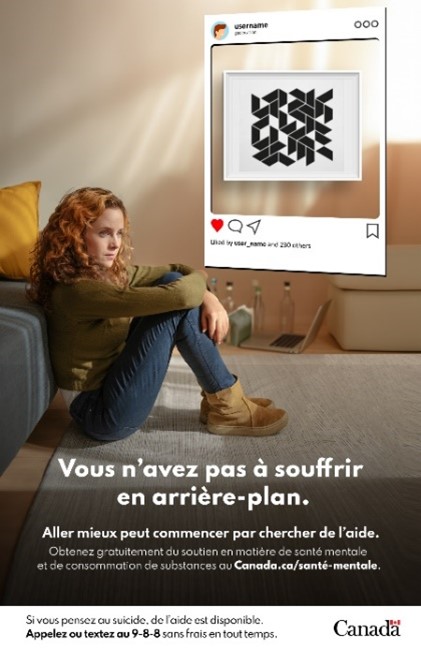
Youth/Young adults 16 to 34 (variation 2)
* tested in groups #5, 19 and 23 and as alternative variation in all other groups with all audiences starting Nov 29
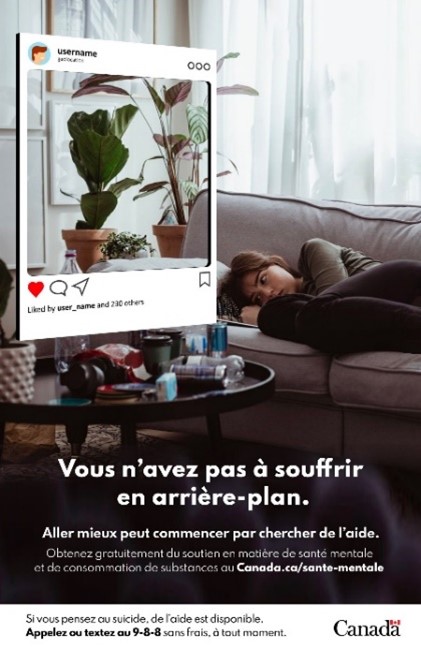
Jeunes/jeunes adultes de 16 à 34 ans (version 1)
Femme assise par terre dans un salon. Un cadre de style média sociaux dans un coin montre un cadre sur le mur.
Vous n'avez pas à souffrir en arrière-plan.
Aller mieux peut commencer par chercher de l'aide.
Obtenez gratuitement du soutien en matière de santé mentale et de consommation de substances au Canada.ca/santé-mentale.
Si vous pensez au suicide, de l'aide est disponible.
Appelez ou textez au 9-8-8 sans frais en tout temps.
Canada
Jeunes/jeunes adultes de 16 à 34 ans (version 2)
Femme couché sur un sofa dans un salon. Un cadre de style média sociaux dans un coin montre des plantes.
Vous n'avez pas à souffrir en arrière-plan.
Aller mieux peut commencer par chercher de l'aide.
Obtenez gratuitement du soutien en matière de santé mentale et de consommation de substances au Canada.ca/santé-mentale.
Si vous pensez au suicide, de l'aide est disponible.
Appelez ou textez au 9-8-8 sans frais en tout temps.
Canada



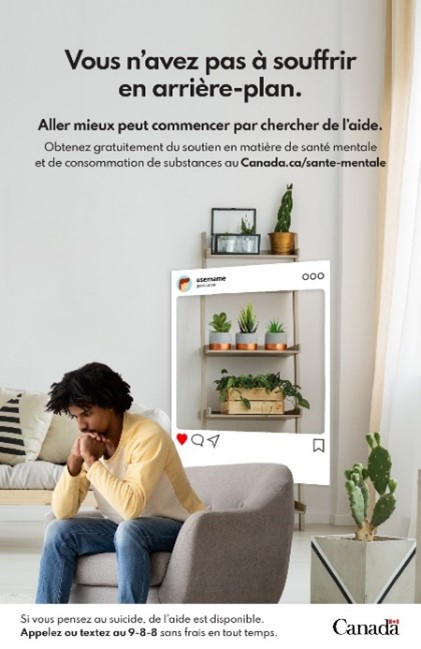
Autochtones
Un homme assis sur une roche près d'un cour d'eau entouré de montagnes. Un cadre de style média sociaux dans un coin montre un oiseau et des montagnes avec la mention Lac Kluane. 2022.
Vous n'avez pas à souffrir en arrière-plan.
Aller mieux peut commencer par chercher de l'aide.
Obtenez gratuitement du soutien en matière de santé mentale et de consommation de substances au Canada.ca/santé-mentale.
Si vous pensez au suicide, de l'aide est disponible.
Appelez ou textez au 9-8-8 sans frais en tout temps.
Canada
Communauté 2ELGBTQI+
Un homme assis sur un sofa et un autre près d'une fenêtre. Un cadre de style média sociaux dans un coin montre la vue d'une ville par une fenêtre avec la mention Superbe vue et un coeur.
Vous n'avez pas à souffrir en arrière-plan.
Aller mieux peut commencer par chercher de l'aide.
Obtenez gratuitement du soutien en matière de santé mentale et de consommation de substances au Canada.ca/santé-mentale.
Si vous pensez au suicide, de l'aide est disponible.
Appelez ou textez au 9-8-8 sans frais en tout temps.
Canada
Parents/tuteurs
Une femme dans une cuisine. Un cadre de style média sociaux dans un coin montre croissant avec des fruit et un verre de jus d'orange.
Vous n'avez pas à souffrir en arrière-plan.
Aller mieux peut commencer par chercher de l'aide.
Obtenez gratuitement du soutien en matière de santé mentale et de consommation de substances au Canada.ca/santé-mentale.
Si vous pensez au suicide, de l'aide est disponible.
Appelez ou textez au 9-8-8 sans frais en tout temps.
Canada
Personnes racialisées
Un homme assis sur un sofa. Un cadre de style média sociaux dans un coin montre des plantes.
Vous n'avez pas à souffrir en arrière-plan.
Aller mieux peut commencer par chercher de l'aide.
Obtenez gratuitement du soutien en matière de santé mentale et de consommation de substances au Canada.ca/santé-mentale.
Si vous pensez au suicide, de l'aide est disponible.
Appelez ou textez au 9-8-8 sans frais en tout temps.
Canada

Hommes de 35 ans et plus
Un homme assis sur un banc de parc. Un cadre semblable à celui lorsqu'on prend une photo montre une femme et un enfant.
Vous n'avez pas à souffrir en arrière-plan.
Aller mieux peut commencer par chercher de l'aide.
Obtenez gratuitement du soutien en matière de santé mentale et de consommation de substances au Canada.ca/santé-mentale.
Si vous pensez au suicide, de l'aide est disponible.
Appelez ou textez au 9-8-8 sans frais en tout temps.
Canada
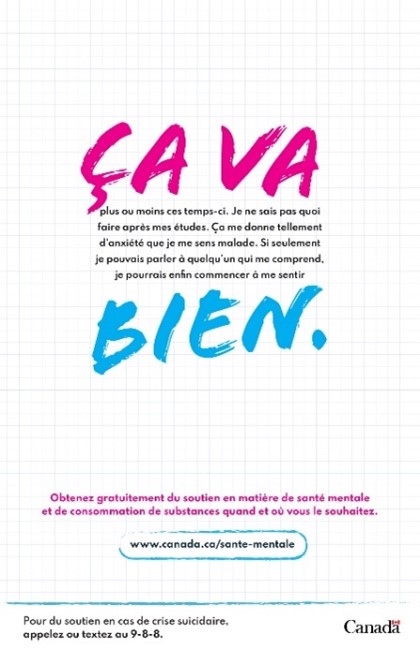

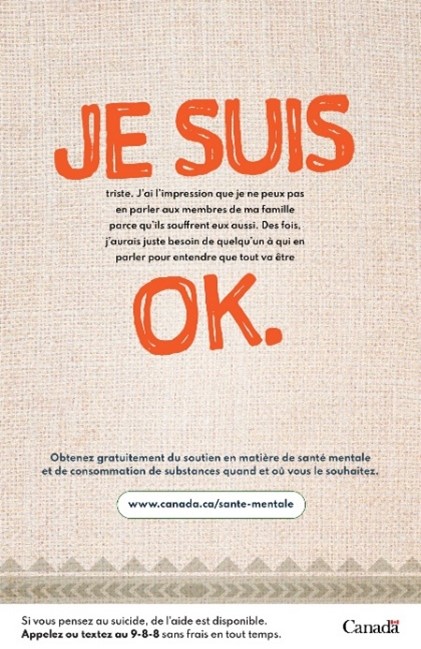

Jeunes/jeunes adultes de 16 à 34 ans
Ça va plus ou moins ces temps-ci. Je ne sais pas quoi faire après mes études. Ça me donne tellement d'anxiété que je me sens malade. Si seulement je pouvais parler à quelqu'un qui me comprend, je pourrais enfin commencer à me sentir bien.
Obtenez gratuitement du soutien en matière de santé mentale et de consommation de substances quand et où vous le souhaitez. www.canada.ca/santé-mentale.
Pour du soutien en cas de crise suicidaire, appelez ou textez au 9-8-8.
Canada
Hommes de 35 ans et plus
Je me sens en détresse en ce moment. Je ne supporte pas l'idée de paraître vulnérable, mais il est temps de faire quelque chose et d'arrêter de prétendre que tout va bien.
Obtenez gratuitement du soutien en matière de santé mentale et de consommation de substances quand et où vous le souhaitez. www.canada.ca/santé-mentale.
Pour du soutien en cas de crise suicidaire, appelez ou textez au 9-8-8.
Canada
Autochtones
Je suis triste. J'ai l'impression que je ne peux pas en parler aux membres de ma famille parce qu'ils souffrent eux aussi. Des fois, j'aurais juste besoin de quelqu'un à qui en parler pour entendre que tout va être ok.
Obtenez gratuitement du soutien en matière de santé mentale et de consommation de substances quand et où vous le souhaitez. www.canada.ca/santé-mentale.
Pour du soutien en cas de crise suicidaire, appelez ou textez au 9-8-8.
Canada
Communauté 2ELGBTQI+
Autochtones
Je n'ai jamais été moi-même jusqu'à présent. Je me préoccupe toujours de ce que les autres pensent ou disent de moi à propos de mon apparence. Je pensais pouvoir m'en sortir, mais je pense que j'ai besoin d'aide pour me sentir mieux.
Obtenez gratuitement du soutien en matière de santé mentale et de consommation de substances quand et où vous le souhaitez. www.canada.ca/santé-mentale.
Pour du soutien en cas de crise suicidaire, appelez ou textez au 9-8-8.
Canada

Parents/tuteurs; personnes racialisées
Tout va de travers : le travail, la famille. J'arrive pas à suivre, encore moins à avancer. J'ai l'impression que la chance n'est pas mon côté. Peut-être que parler à quelqu'un me ferait du bien.
Obtenez gratuitement du soutien en matière de santé mentale et de consommation de substances quand et où vous le souhaitez. www.canada.ca/santé-mentale.
Pour du soutien en cas de crise suicidaire, appelez ou textez au 9-8-8.
Canada
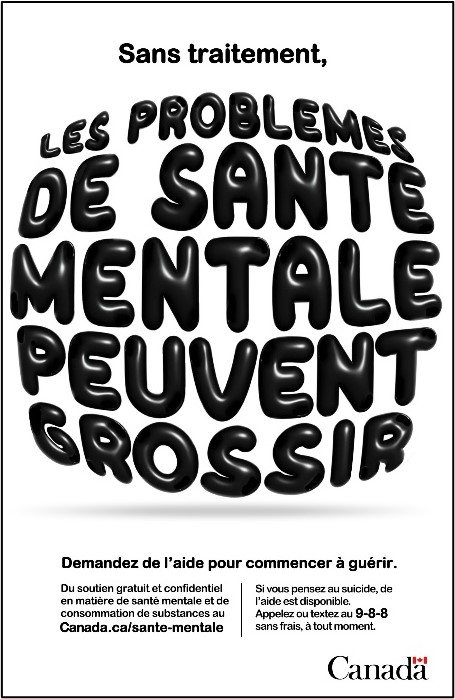
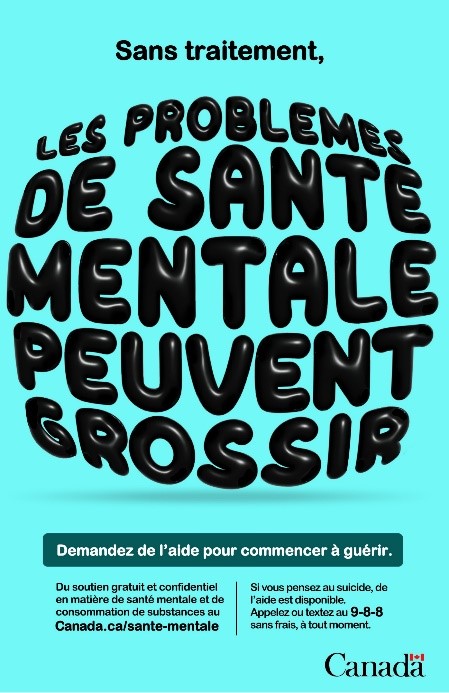
Première version
Sans traitement, les problèmes de santé mentale peuvent grossir.
Demandez de l'aide pour commencer à guérir.
Du soutien gratuit et confidentiel en matière de santé mentale et de consommation de substances au Canada.ca/sante-mentale
Si vous pensez au suicide, de l'aide est disponible. Appelez ou textez au 9-8-8 sans frais, à tout moment.
Deuxième version
Sans traitement, les problèmes de santé mentale peuvent grossir.
Demandez de l'aide pour commencer à guérir.
Du soutien gratuit et confidentiel en matière de santé mentale et de consommation de substances au Canada.ca/sante-mentale
Si vous pensez au suicide, de l'aide est disponible. Appelez ou textez au 9-8-8 sans frais, à tout moment.
i Canadian Mental Health Association (2023). New data reveals that 87% of people living in Canada want universal mental health care.
ii HC and PHAC. SPB data - internal.
iii 30% rated their mental health as average, while 12% rated their mental health as bad or very bad. The "average" rating is placed in the bottom three as part of a standardized scale in academic research. Together, average, bad and very bad make up the "total bad" rating.
iv HC (2022). COVID-19 tracking survey: Wave 18. Health Canada. COVID-19 Tracking Survey: Wave 20. Data collection from Jan. 12 to 30, 2022, p. 19
v CAMH, Talk Suicide Canada, and Innovative Research Group (2023). Talk Suicide Canada brand awareness and 988 research - Survey results June 2023 Draft Report.
vi Statistics Canada (2022). https://www.canada.ca/en/public-health/services/publications/healthy-living/suicide-canada-key-statistics-infographic.html.
vii Statistics Canada (2022).
viii PHAC (2023). Suicide in Canada.
ix Statistics Canada (2022). https://www150.statcan.gc.ca/t1/tbl1/en/tv.action?pid=1310039401.
x Canadian Mental Health Association (2023). New data reveals that 87% of people living in Canada want universal mental health care.
xi HC and PHAC. SPB data - internal.
xii 30% rated their mental health as average, while 12% rated their mental health as bad or very bad. The "average" rating is placed in the bottom three as part of a standardized scale in academic research. Together, average, bad and very bad make up the "total bad" rating.
xiii HC (2022). COVID-19 tracking survey: Wave 18. Health Canada. COVID-19 Tracking Survey: Wave 20. Data collection from Jan. 12 to 30, 2022, p. 19
xiv CAMH, Talk Suicide Canada, and Innovative Research Group (2023). Talk Suicide Canada brand awareness and 988 research - Survey results June 2023 Draft Report.
xv Statistics Canada (2022). https://www.canada.ca/en/public-health/services/publications/healthy-living/suicide-canada-key-statistics-infographic.html.
xvi Statistics Canada (2022).
xvii PHAC (2023). Suicide in Canada.
xviii Statistics Canada (2022). https://www150.statcan.gc.ca/t1/tbl1/en/tv.action?pid=1310039401.